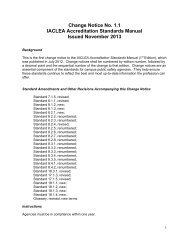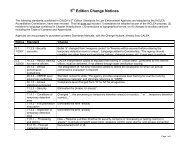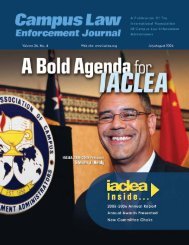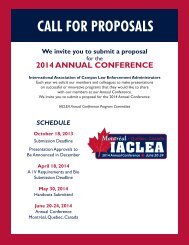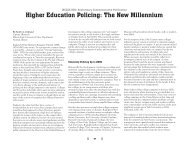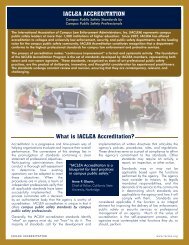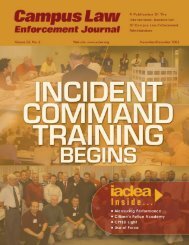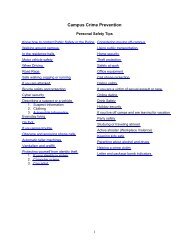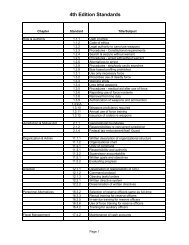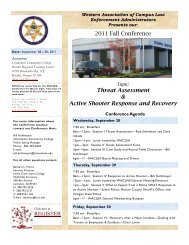Dear Colleague Letter - U.S. Department of Education
Dear Colleague Letter - U.S. Department of Education
Dear Colleague Letter - U.S. Department of Education
You also want an ePaper? Increase the reach of your titles
YUMPU automatically turns print PDFs into web optimized ePapers that Google loves.
Page 2 – <strong>Dear</strong> <strong>Colleague</strong> <strong>Letter</strong>: Sexual Violence<br />
sexual assault, sexual battery, and sexual coercion. All such acts <strong>of</strong> sexual violence are forms <strong>of</strong><br />
sexual harassment covered under Title IX.<br />
The statistics on sexual violence are both deeply troubling and a call to action for the nation. A<br />
report prepared for the National Institute <strong>of</strong> Justice found that about 1 in 5 women are victims<br />
<strong>of</strong> completed or attempted sexual assault while in college. 3 The report also found that<br />
approximately 6.1 percent <strong>of</strong> males were victims <strong>of</strong> completed or attempted sexual assault<br />
during college. 4 According to data collected under the Jeanne Clery Disclosure <strong>of</strong> Campus<br />
Security and Campus Crime Statistics Act (Clery Act), 20 U.S.C. § 1092(f), in 2009, college<br />
campuses reported nearly 3,300 forcible sex <strong>of</strong>fenses as defined by the Clery Act. 5 This problem<br />
is not limited to college. During the 2007-2008 school year, there were 800 reported incidents<br />
<strong>of</strong> rape and attempted rape and 3,800 reported incidents <strong>of</strong> other sexual batteries at public<br />
high schools. 6 Additionally, the likelihood that a woman with intellectual disabilities will be<br />
sexually assaulted is estimated to be significantly higher than the general population. 7 The<br />
<strong>Department</strong> is deeply concerned about this problem and is committed to ensuring that all<br />
students feel safe in their school, so that they have the opportunity to benefit fully from the<br />
school’s programs and activities.<br />
This letter begins with a discussion <strong>of</strong> Title IX’s requirements related to student-on-student<br />
sexual harassment, including sexual violence, and explains schools’ responsibility to take<br />
immediate and effective steps to end sexual harassment and sexual violence. These<br />
requirements are discussed in detail in OCR’s Revised Sexual Harassment Guidance issued in<br />
2001 (2001 Guidance). 8 This letter supplements the 2001 Guidance by providing additional<br />
guidance and practical examples regarding the Title IX requirements as they relate to sexual<br />
violence. This letter concludes by discussing the proactive efforts schools can take to prevent<br />
sexual harassment and violence, and by providing examples <strong>of</strong> remedies that schools and OCR<br />
may use to end such conduct, prevent its recurrence, and address its effects. Although some<br />
examples contained in this letter are applicable only in the postsecondary context, sexual<br />
3 CHRISTOPHER P. KREBS ET AL., THE CAMPUS SEXUAL ASSAULT STUDY: FINAL REPORT xiii (Nat’l Criminal Justice Reference Serv.,<br />
Oct. 2007), available at http://www.ncjrs.gov/pdffiles1/nij/grants/221153.pdf. This study also found that the<br />
majority <strong>of</strong> campus sexual assaults occur when women are incapacitated, primarily by alcohol. Id. at xviii.<br />
4 Id. at 5-5.<br />
5 U.S. <strong>Department</strong> <strong>of</strong> <strong>Education</strong>, Office <strong>of</strong> Postsecondary <strong>Education</strong>, Summary Crime Statistics (data compiled from<br />
reports submitted in compliance with the Clery Act), available at<br />
http://www2.ed.gov/admins/lead/safety/criminal2007-09.pdf. Under the Clery Act, forcible sex <strong>of</strong>fenses are<br />
defined as any sexual act directed against another person, forcibly and/or against that person’s will, or not forcibly<br />
or against the person’s will where the victim is incapable <strong>of</strong> giving consent. Forcible sex <strong>of</strong>fenses include forcible<br />
rape, forcible sodomy, sexual assault with an object, and forcible fondling. 34 C.F.R. Part 668, Subpt. D, App. A.<br />
6 SIMONE ROBERS ET AL., INDICATORS OF SCHOOL CRIME AND SAFETY: 2010 at 104 (U.S. Dep’t <strong>of</strong> Educ. & U.S. Dep’t <strong>of</strong> Justice,<br />
Nov. 2010), available at http://nces.ed.gov/pubs2011/2011002.pdf.<br />
7 ERIKA HARRELL & MICHAEL R. RAND, CRIME AGAINST PEOPLE WITH DISABILITIES, 2008 (Bureau <strong>of</strong> Justice Statistics, U.S. Dep’t<br />
<strong>of</strong> Justice, Dec. 2010), available at http://bjs.ojp.usdoj.gov/content/pub/pdf/capd08.pdf.<br />
8 The 2001 Guidance is available on the <strong>Department</strong>’s Web site at<br />
http://www2.ed.gov/about/<strong>of</strong>fices/list/ocr/docs/shguide.pdf. This letter focuses on peer sexual harassment and<br />
violence. Schools’ obligations and the appropriate response to sexual harassment and violence committed by<br />
employees may be different from those described in this letter. Recipients should refer to the 2001 Guidance for<br />
further information about employee harassment <strong>of</strong> students.



